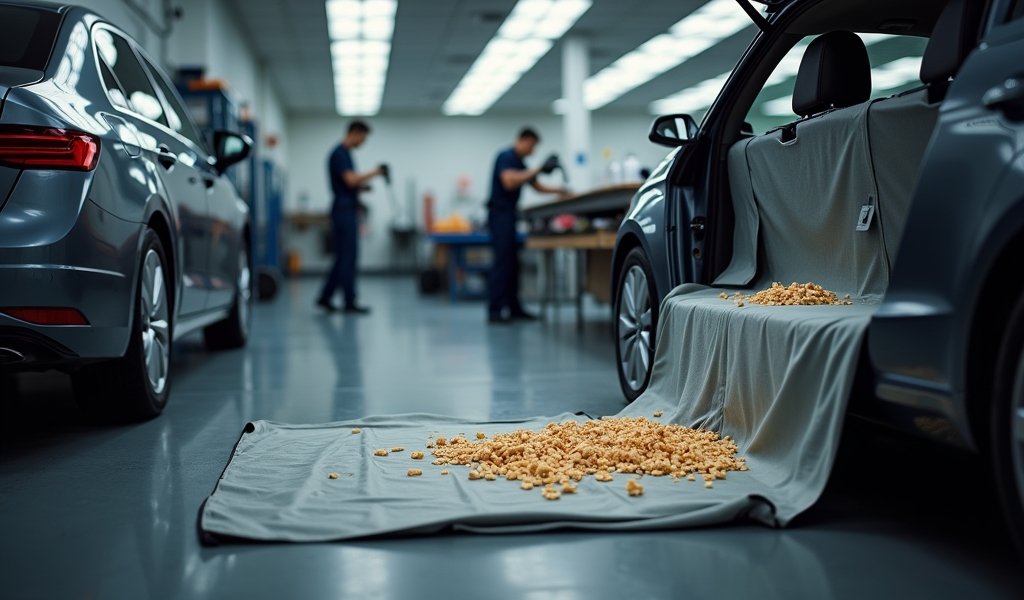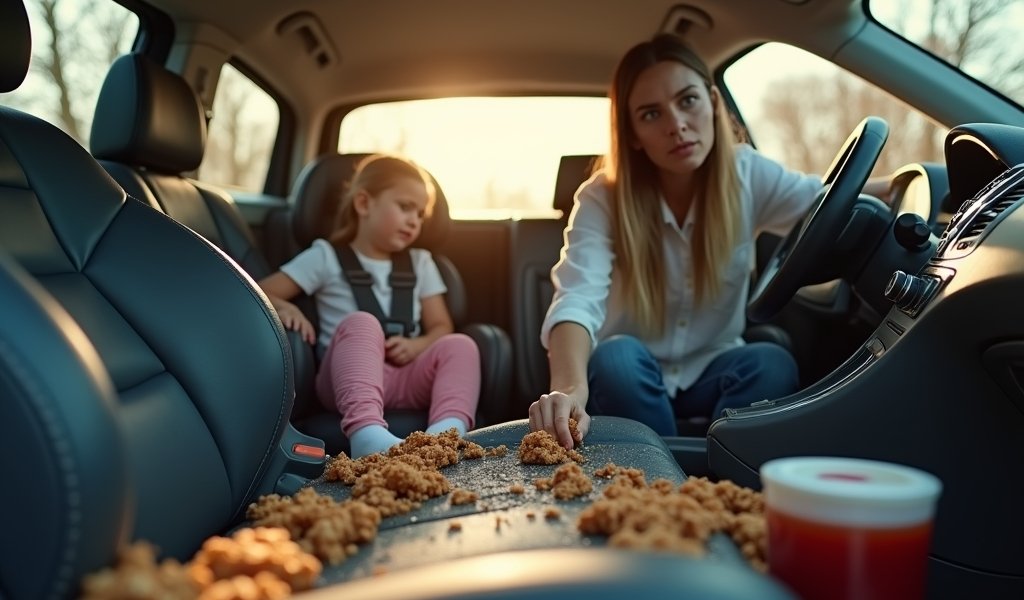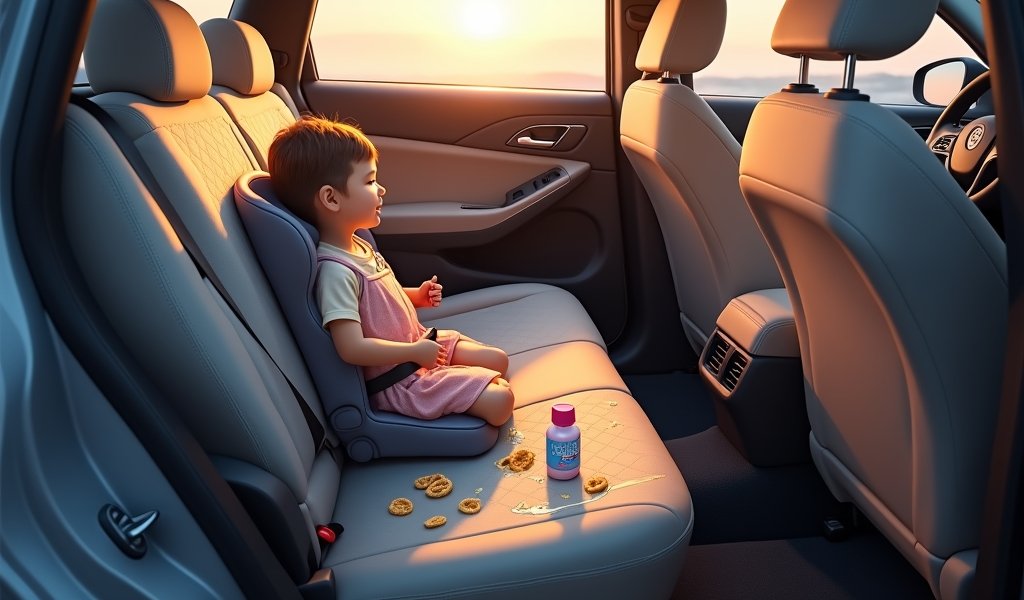Overview
This article provides five practical strategies for protecting car interiors from children’s food messes: using quality seat protectors, selecting car-friendly snacks, creating designated eating zones, preparing an emergency cleanup kit, and establishing regular maintenance routines. It emphasizes balancing protection with convenience while maintaining a positive family travel experience, offering specific product recommendations and techniques for immediate spill response and long-term maintenance.
Table of Contents
- Understanding the Challenge: Kids, Food, and Your Car’s Interior
- Tip #1: Invest in Quality Seat Protectors
- Tip #2: Strategic Snack Selection for Road Trips
- Tip #3: Create Designated Eating Zones
- Tip #4: Assemble an Emergency Cleanup Kit
- Tip #5: Establish a Regular Maintenance Routine
- Balancing Convenience and Protection
- Conclusion
- Frequently Asked Questions
Understanding the Challenge: Kids, Food, and Your Car’s Interior
As both a mechanic and a parent, I’ve seen firsthand how quickly child food spills in cars can transform a pristine interior into what looks like a food fight crime scene. Those Cheerios that somehow find their way into every crevice? The mysterious juice stains that appear seemingly out of nowhere? They’re all part of the parenting journey that can take a serious toll on your vehicle’s upholstery and resale value.
Child food spills car protection isn’t just about maintaining appearances—it’s about preserving your investment. The average American spends over 300 hours per year in their vehicle, and for families, many of those hours involve snacking children. Without proper protection, these innocent moments can lead to permanent staining, unpleasant odors, and even mold growth in extreme cases.
But here’s the good news: with some strategic planning and the right tools, you can create a family-friendly vehicle that stands up to the inevitable messes while keeping your sanity intact. Let’s dive into five professional-grade solutions that strike the perfect balance between practicality and protection.
Tip #1: Invest in Quality Seat Protectors
When it comes to child food spills car protection, your first line of defense should be high-quality seat protectors designed specifically for families. Unlike basic seat covers, premium protectors offer waterproof barriers, reinforced stitching at stress points, and materials that can withstand repeated cleaning without breaking down.
Look for seat protectors with these key features:
- Waterproof backing that prevents liquids from seeping through to your upholstery
- Non-slip surface gripping that keeps the protector securely in place during drives
- High side walls that contain spills rather than allowing them to run off onto your floor mats
- Machine-washable materials that simplify the cleaning process
The investment in quality seat protection pays dividends over time. A set of premium waterproof car seat covers for spills typically ranges from $30-100 depending on coverage area, but can save hundreds in professional cleaning or upholstery repair costs down the road.
Beyond the obvious protection benefits, these covers also create peace of mind. With proper coverage in place, you can relax a bit about those inevitable spills instead of experiencing that moment of panic when you hear “Uh-oh!” from the backseat.

Tip #2: Strategic Snack Selection for Road Trips
An often overlooked aspect of child food spills car protection is what I call “strategic snacking.” As someone who’s detailed countless family vehicles, I can tell you with certainty: not all snacks are created equal when it comes to in-car consumption.
The worst offenders are typically:
- Chocolate and candy (melts and creates sticky residues that bond to fabrics)
- Brightly colored fruit juices (contain dyes that can permanently stain)
- Crumbly cookies and crackers (create fine particles that work into seams)
- Yogurt and pudding cups (tip easily and create dairy-based messes that can sour)
Instead, consider packing these car-friendly alternatives:
- Fresh fruit slices in sealed containers (grapes, apple slices, berries)
- Dry cereal in spill-resistant snack cups
- String cheese or cheese sticks (minimal mess potential)
- Water in spill-proof bottles rather than juice boxes
- Freeze-dried fruit crisps that dissolve rather than stain if dropped
According to a Consumer Reports survey, nearly 70% of parents report that certain foods cause significantly more interior damage than others. By being selective about what snacks make the journey, you’re implementing a preemptive child food spills car protection strategy that requires minimal effort.
Remember that timing matters too. Consider limiting in-car eating to necessary situations rather than making it a default activity during every drive. This small adjustment can dramatically reduce your cleaning workload over time.
Tip #3: Create Designated Eating Zones
Creating designated eating zones within your vehicle represents one of the most effective child food spills car protection strategies I recommend to parents. Rather than allowing a free-for-all approach to in-car dining, establishing clear boundaries can contain potential messes to specific, easily cleanable areas.
Start by selecting a single area of your vehicle as the “dining section.” This could be one row of seating or even just one seat position. Next, create a clearly defined perimeter using waterproof mats that extend beyond the immediate seating area to catch the inevitable fallout from snack time.
For maximum protection, consider these designated zone elements:
- Silicone or plastic trays that attach securely to car seats or strollers
- Catch-all bibs that create a crumb-catching pocket (these work wonders even for older children)
- Washable fabric seat pockets that keep snacks organized and prevent fishing around on the floor
- Clear rules about when and where eating happens in the vehicle
The psychology behind this approach is sound: children respond well to consistent boundaries. By establishing that food stays in specific zones, you’re not just protecting car seats from food and drink damage—you’re also teaching valuable lessons about responsibility and respect for shared spaces.
Parents who implement designated eating zones report significantly reduced cleaning time and less frustration overall. The key is consistency in enforcement while maintaining a positive atmosphere. Remember, the goal isn’t to create stress around eating, but rather to channel the inevitable messes into manageable areas.
Tip #4: Assemble an Emergency Cleanup Kit
Even with the best child food spills car protection systems in place, emergencies happen. As a mechanic who’s rehabilitated countless family vehicles, I can tell you that having the right tools on hand for immediate response can be the difference between a quick cleanup and permanent damage.
Your emergency kit should be compact enough to store in your glove compartment or center console while containing all the essentials for rapid response. Here’s what I recommend including:
- Microfiber cloths (they absorb more liquid and cause less damage than paper towels)
- A package of gentle baby wipes (perfect for sticky hands and surfaces)
- A small spray bottle with diluted white vinegar solution (1:4 ratio with water)
- A travel-size stain remover stick or wipes specifically formulated for upholstery
- Small trash bags for containing wet or soiled cleanup materials
- A plastic scraper tool for removing dried substances without damaging fabrics
The golden rule of spill management is speed. According to research from interior restoration specialists, addressing a spill within the first 30 seconds dramatically increases your chances of preventing permanent staining. That’s why having these tools within arm’s reach is crucial.
For particularly challenging spills like berry juice or tomato sauce, remember that blotting (not rubbing) is the proper technique. Apply your cleaning solution sparingly, working from the outside edge toward the center to prevent spreading the stain. This professional technique prevents the dreaded “clean ring” that often appears around treated areas.

Tip #5: Establish a Regular Maintenance Routine
The final pillar of effective child food spills car protection is establishing a consistent maintenance schedule. As someone who’s restored countless family vehicles, I can confidently say that regular light maintenance prevents the need for intensive deep cleaning sessions later.
Consider implementing this simple weekly routine:
- Remove and shake out removable floor mats and seat protectors
- Use a handheld vacuum with crevice tool to capture crumbs before they become ground in
- Wipe down high-touch surfaces with a gentle car interior cleaner for coffee spills and other common stains
- Check under seats and in seat cracks for forgotten food items that could cause odors
- Empty all cup holders and door compartments of accumulated wrappers and containers
This 15-minute weekly ritual prevents the buildup that makes thorough cleaning such a daunting task. Additionally, monthly application of a fabric protectant to clean upholstery creates an invisible barrier that makes future cleanups significantly easier.
For leather or vinyl surfaces, use conditioners specifically formulated for automotive interiors rather than household products. These specialized formulations prevent the drying and cracking that can occur when food acids contact these materials repeatedly.
Remember that consistency is more important than intensity. A quick weekly once-over prevents the need for intensive quarterly deep cleans that can take hours. This approach aligns with professional detailer recommendations for maintaining vehicle value while minimizing the time investment required.
Balancing Convenience and Protection
Finding the sweet spot between convenience and protection is perhaps the most challenging aspect of child food spills car protection. As both a mechanic and a parent, I understand the real-world constraints families face. The perfect theoretical solution isn’t helpful if it creates more stress than it solves.
Consider implementing a “progressive protection” approach where you match your effort level to the situation:
- For quick errands: Basic seat protectors and a no-food rule may suffice
- For daily commutes: Add designated eating zones and strategic snack selection
- For road trips: Deploy your full arsenal of protectors, trays, and backup supplies
This flexible system acknowledges that different situations warrant different levels of preparation. You wouldn’t use the same approach for a five-minute drive to school as you would for a cross-country road trip.
Remember that the goal is to reduce stress, not add to it. If your child food spills car protection strategy creates more tension than it relieves, it’s time to reevaluate and simplify. The perfect balance exists where your vehicle remains reasonably clean without creating undue burden on your family routines.
Many parents find success by involving children in the protection process as they grow. Even toddlers can learn to eat over catch trays, and elementary-aged children can take responsibility for basic cleanup of their areas. This collaborative approach not only protects your vehicle but teaches valuable life skills.
Conclusion
Effective child food spills car protection isn’t about achieving perfection—it’s about creating systems that work for your unique family situation. By implementing quality seat protectors, being strategic about snack choices, establishing designated eating zones, preparing for emergencies, and maintaining a simple cleaning routine, you can dramatically reduce the impact of inevitable spills.
Remember that your vehicle is meant to transport your family through life’s adventures, spills and all. With these five professional-grade strategies, you can protect your investment without sacrificing the joy of family travel. The peace of mind that comes from knowing you’re prepared for messes allows you to focus on what really matters: making memories with your children, sticky fingers and all.
The next time you hear that dreaded “Oops!” from the backseat, you’ll be ready not just to respond, but to prevent many common issues before they happen. Your future self (and your future trade-in value) will thank you for the effort you put into child food spills car protection today.
Frequently Asked Questions
What’s the best immediate response to a liquid spill in my car?
Blot (don’t rub) the spill with microfiber cloths to absorb as much liquid as possible. Follow immediately with a gentle cleaner appropriate for your upholstery type.
Are aftermarket seat covers worth the investment for protecting against food spills?
Quality aftermarket seat covers are definitely worth the investment as they provide a removable, washable barrier between spills and your actual upholstery. Look for waterproof options with secure attachment systems.
How can I remove set-in food stains from car upholstery?
For set-in stains, create a paste with baking soda and water, apply to the stain, let it dry completely, then vacuum thoroughly. For stubborn stains, consider a professional upholstery cleaner formulated for automotive use.
What’s the most effective way to prevent drink spills in car cup holders?
Use spill-proof cups with secure lids for children, and consider silicone cup holder liners that can be removed and washed. Some parents find success with cup holder expanders that provide a more secure fit for children’s bottles.
How often should I deep clean my car if my children regularly eat inside?
With regular children’s snacking, perform weekly quick cleanups and schedule a more thorough deep clean monthly. This frequency prevents buildup while keeping the maintenance workload manageable.

